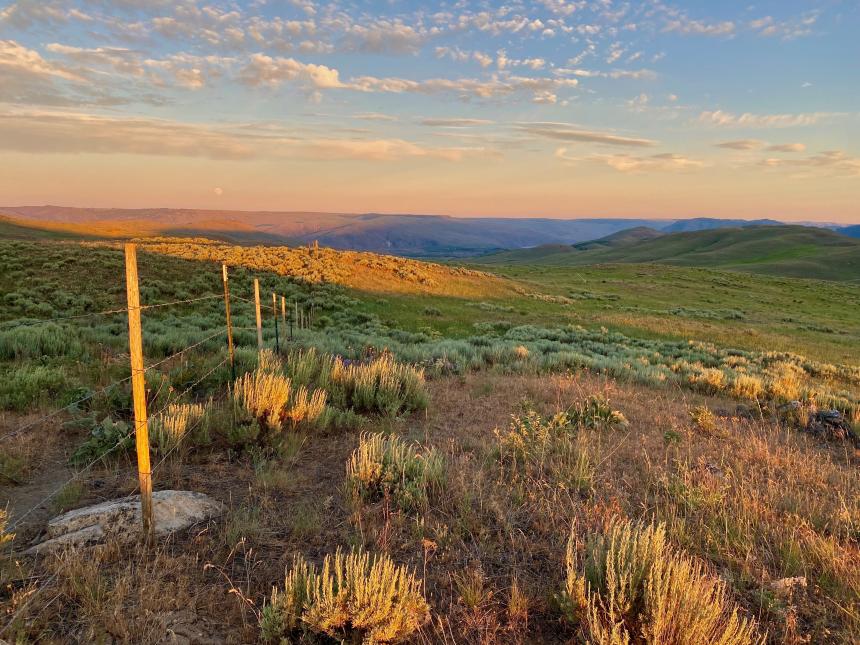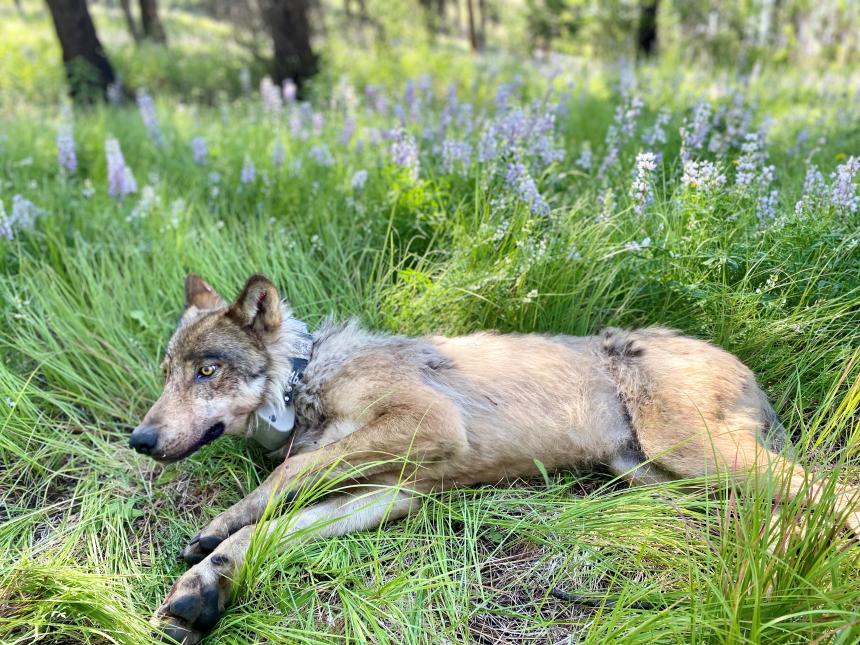This update provides an overview of gray wolf conservation and management activities in Washington during June 2021.
Program updates
WDFW staff recently shared presentations and documents related to two wolf policy projects: Wolf-livestock conflict deterrence rule making and post-recovery planning for wolves.
- Wolf-livestock conflict deterrence rule making
- Wolf post-recovery planning
University of Washington (UW) Periodic Wolf Status Review – Briefing
On July 16 from 10 a.m. to 11 a.m., the Fish and Wildlife Commission will be briefed by a team from the University of Washington on the status of the modeling tool that will be used by WDFW to make a recommendation for wolf status review.
Staff Report: Donny Martorello, Ph.D., Wolf Policy Lead, Sarah Converse, Associate Professor/Leader with the Washington Cooperative Fish and Wildlife Research Unit, Beth Gardner, UW Associate Professor
WHERE: This meeting will take place via Zoom. The link for the public to listen to the discussion is: (https://zoom.us/j/96654328225)
To join via phone please choose a number below and then you’ll be prompted to enter the Webinar ID: 966-5432-8225
1-253-215-8782 or 1-833-548-0282 (Toll Free)
Communication and coordination
A WDFW wolf biologist gave a presentation on carnivores in Washington to Kittitas Search and Rescue this past month.
Current population status and proactive conflict mitigation
The year-end minimum population count for 2020 was at least 132 known wolves in 24 known packs including at least 13 breeding pairs. The Confederated Tribes of the Colville Reservation reported 46 wolves in five packs. Annual wolf population surveys are conducted in the winter because wolf populations experience the least amount of natural fluctuation during this time. Counting the population at the end of each year allows for comparable year-to-year trends at a time of year when the wolf population is most stable. The year-end minimum population count for 2021 will be released in April 2022.
Reports of remote camera images or videos, wolf tracks, or sightings from the public are extremely helpful in locating previously undocumented wolf activity and potential new packs on the landscape. Please take photos of wolves or wolf sign (use some way to measure the size of a track) and upload them to the wolf reporting page via the following link: https://wdfw.wa.gov/species-habitats/at-risk/species-recovery/gray-wolf/observations
Definitions: A “pack” is defined as two or more wolves traveling together in winter, and a “breeding pair” is defined as at least one adult male and one adult female wolf that raised at least two pups that survived until December 31. In any given year, the number of packs will always be greater than or equal to the number of breeding pairs. The known territories and more information for each pack can be viewed by clicking the pack name.
Beaver Creek pack
No activity to report.
Butte Creek pack
No activity to report.
Carpenter Ridge pack
No activity to report.
Diobsud Creek pack
No activity to report.
Dirty Shirt pack
WDFW wolf biologists spent time scouting and trapping in the Dirty Shirt pack territory. They captured and collared a yearling wolf from this pack in June.
Goodman Meadows pack
No activity to report.
Grouse Flats pack
No activity to report.
Huckleberry pack
No activity to report.
Kettle pack
WDFW wolf biologists captured, collared, and released an adult wolf in the Kettle territory in June. Based on locations from this wolf’s collar as well as locations from a wolf collared in the Togo territory in May, biologists believe there is one pack utilizing the traditional Kettle and Togo wolf pack territories at this time. WDFW will refer to this pack as Togo unless there is evidence of two packs using the area.
Leadpoint pack
No activity to report.
Lookout pack
No activity to report.
Loup Loup pack
No activity to report.
Naneum pack
No activity to report.
Navarre pack
No activity to report.
Onion Creek pack
No activity to report.
Salmo pack
No activity to report.
Sherman pack
No activity to report.
Skookum pack
No activity to report.
Smackout pack
No activity to report.
Stranger pack
No activity to report.
Strawberry pack
No activity to report.
Sullivan Creek pack
WDFW wolf biologists captured, collared, and released two adult wolves in the Sullivan Creek pack.


Teanaway pack
A WDFW wolf biologist placed cameras for monitoring in the the Teanaway pack territory this past month.
Togo pack
WDFW wolf biologists captured, collared, and released an adult wolf in the Kettle territory in June. Based on locations from this wolf’s collar as well as locations from the wolf collared in the Togo territory in May, biologists believe there is one pack utilizing the traditional Kettle and Togo wolf pack territories at this time. WDFW will refer to this pack as Togo unless there is evidence of two packs using the area.
On June 24, a livestock producer discovered an injured calf on an allotment comprised of both public and private grazing leases in the Togo pack territory. The livestock producer reportedly last saw the uninjured calf on June 20.
WDFW staff investigated the calf and found multiple injuries including a large laceration with signs of swelling and infection on the upper left hamstring. Staff discovered long scrape marks consistent with wolf dentition adjacent to the laceration. Staff also noted several smaller marks and lacerations on the inner right hamstring as well as a puncture wound. Staff estimated the injuries to be two to three days old.
WDFW staff who conducted the investigation made a determination that the injuries sustained were a result of a confirmed wolf depredation. The decision was based on the nature and location of the injuries (which were consistent with those made during a wolf depredation event), recent known wolf locations, trail camera activity in the area, and the presence of fresh wolf tracks where the calf was discovered.
The affected livestock producer had several proactive, nonlethal deterrents in place, including focused monitoring on private calving pastures, daily range rider activity, checking livestock daily, delayed turnout of cattle (allows elk calves, moose calves and deer fawns to become available as prey), removing sick or injured livestock, spotlighting in the allotment, hazing of wolves in close proximity to the cattle herd, avoidance of known areas of high wolf activity and sanitation of carcasses or other attractants.
The livestock producer transported the injured calf back to ranch headquarters to tend to the wounds and to monitor health and healing. A WDFW Wildlife Conflict Specialist deployed a RAG box near where the calf was discovered, and also showed the livestock producer and family how to use telemetry equipment to detect cattle with previously deployed VHF ear tag transmitters. All parties discussed range riding options and the amount of coverage the producer and family are able to provide. The Wildlife Conflict Specialist contacted a WDFW-contracted range rider to maintain daily to near daily range riding coverage. The producer and family agreed to start performing nightly deterrence patrols in addition to their other range riding duties.
Touchet pack
No activity to report.
Tucannon pack
A WDFW wolf biologist scouted for wolf sign and trapped to collar wolves in the Tucannon pack this past month; no wolves were captured during this effort.
Vulcan pack
No activity to report.
Wedge pack
No activity to report.
Miscellaneous/lone wolves
No activity to report.
Note: The Frosty, Nason, Nc’icn, and Whitestone pack territories are within Confederated Tribes of the Colville Reservation (CTCR) lands and are managed under tribal authority. Information regarding these packs is proprietary and reported at the discretion of the CTCR.
Mortalities
No wolf mortalities were documented in June. As of this update, WDFW has documented three wolf mortalities in 2021.
Depredation activity
Please report any suspected livestock depredations or the death or harassment of wolves to the WDFW Enforcement Hotline at 1-877-933-9847.
In 2020, 76% of known wolf packs were not involved in any documented livestock depredation.
Below is a summary of packs with documented depredation activity within the past ten months (some packs have depredation history prior to the current ten-month window; this timeframe is considered based on guidance from the wolf-livestock interaction protocol (PDF)).
|
Pack |
Depredation date |
Depredation type |
Proactive non-lethals |
Ten-month window |
Agency lethal removal actions |
|
Beaver Creek |
8/21/20 |
Probable injury of calf |
Yes |
6/21/21 |
|
|
Leadpoint |
8/3/20 |
Confirmed mortality of calf (calf died from injuries) |
Yes |
6/3/21 |
|
|
|
8/7/20 |
Confirmed injury of calf |
Yes |
6/7/21 |
|
|
|
8/7/20 |
Confirmed injury of calf |
Yes |
6/7/21 |
|
|
|
8/7/20 |
Confirmed injury of calf |
Yes |
6/7/21 |
|
|
|
8/7/20 |
Confirmed kill of calf |
Yes |
6/7/21 |
|
|
|
8/10/20 |
Confirmed injury of calf |
Yes |
6/10/21 |
|
|
|
8/10/20 |
Confirmed kill of calf |
Yes |
6/10/21 |
|
|
|
8/14/20 |
Confirmed injury of calf |
Yes |
6/14/21 |
|
|
|
3/26/21 |
Probable injury of calf |
Yes |
1/26/22 |
|
|
Grouse Flats |
8/12/20 |
Probable injury of calf |
Yes |
6/12/21 |
|
|
Naneum |
5/7/21 |
Confirmed injury of calf |
Yes |
3/7/22 |
|
|
Togo |
6/24/21 |
Confirmed injury of calf |
Yes |
4/24/22 |
|
|
Touchet |
1/16/21 |
Probable kill of calf |
No |
11/16/21 |
|